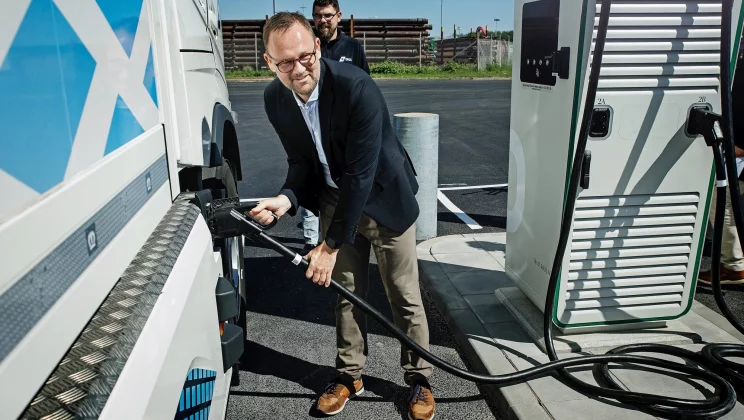As one of the first places in Denmark, Esbjerg now has a public charging station for electric trucks. Transport and logistics companies DFDS and DSV are excited to be able to offer more green transport at the port. The mayor of Esbjerg thinks it is only logical that Port Esbjerg leads the way. Port Esbjerg sees it as another step forward in its strategy of not only being a supplier of green energy but also a green port.
“I’m very pleased and delighted!”
Those were the words of Morten Kjærgaard, Vice President of DSV Road, in mid-May after Norlys had established a charging station for heavy vehicles allowing four electric trucks to charge at the same time.
Each of the four charging points delivers power equivalent to one hundred outlets, so batteries are quickly charged. In fact, so fast that it fits in well with the drivers’ mandatory breaks.
“This way, I actually save time at the charging station,” says Sasa, a DFDS driver of a 12-metre and 44-tonne truck, who on the day of the launch took interested people on a fossil-free and almost noise-free tour of the port. The battery pack is 600 kW, roughly equivalent to seven Teslas.
It takes about two hours to charge the trucks from 0–100 per cent and, in a more realistic scenario, just one hour to go from 30–90 percent.
A huge difference
DFDS has 105 electric trucks in its fleet and 120 more on the way. However, only 15 of them are currently in Denmark, but the electric trucks are coming.
For DFDS, being able to charge locally makes a crucial difference.
“Till now, we have had to drive to other charging points in other cities to charge the trucks we use in Esbjerg, so this makes a big difference. A huge difference,” says Lars Jensen, Driver Master, DFDS.
DFDS transports thousands of trailers at the port for customers like Arla that demand green transport. So, customers further along the chain will also benefit from the charging infrastructure.
DFDS has green ambitions of its own, but equally important the collaboration also means that when the company gets access to charging infrastructure and can offer low-emission logistics solutions to customers in Denmark, it results in even more sustainable transport solutions across the DFDS European network.
“Our electric trucks play a key role in our ambitions to reduce our carbon emissions from road transport,” says Lars Jensen.
Mayor Jesper Frost Rasmussen also participated in the launch. He believes that the charging points are yet another example of Esbjerg taking the lead.
“We will have the first public charging station for heavy vehicles on the west coast. It’s much like a chicken-and-egg situation. One of them has to come first, and it’s no coincidence that, once again, it’s Port Esbjerg and the Municipality of Esbjerg,” he says.
This initiative thus supports the green ambitions of the municipality in terms of being climate neutral by 2030 as well as the green strategy of Port Esbjerg.
“Port Esbjerg has an to support not only the green transition by shipping wind turbines offshore, but also through a number of other initiatives. Among other things, by being a green port. This is just another example of this strategy,” says Dennis Jul Pedersen, CEO, Port Esbjerg.

Jesper Frost, Mayor of the municipality of Esbjerg, had a hard time disguising his happiness for the green progress made once again at Port Esbjerg.
Really close
The Norlys charging station is also very popular at DSV. DSV currently has three electric trucks in Denmark but is in the process of putting into operation upwards of 300 more this year and next year across its operations.
Morten Kjærgaard, Vice President of DSV Road, explains that the lack of charging points has been a major obstacle for quite some time. Diesel vehicles can drive a long stretch on a full tank, while electric vehicles have a range of 225–300 kilometres.
“Achieving the same efficiency remains a challenge, but we are constantly working on it. The more charging points for heavy vehicles, the better the conditions we have as a carrier and haulier,” he explains.
He is very pleased with the new charging station, because DSV’s drivers can now charge their trucks really close to the point from which they transport goods. Moreover, they can charge the vehicles at lightning speed.
With its geographical location, Port Esbjerg is a focal point for combined transports of goods, which makes DSV excited about the initiative, as it aligns with the company’s own green strategy.
“We’re fighting hard on all fronts to get more charging infrastructure, as it will provide greater flexibility. We have bought the trucks and are waiting for the charging infrastructure. But with this initiative, I’m confident that supply and demand will be better aligned from now on,” he says.
DFDS driver Sasa charges his truck three times daily, which fits in nicely with his breaks. “Sometimes it just gets a top-up of 10 per cent, but that’s enough for things to add up at the end of the day,” he explains.
He goes on to say that people are now waiting in line to ‘go green’. “Previously, no drivers wanted to drive electric trucks. Now there’s a waiting list,” he says.
Go to overview

